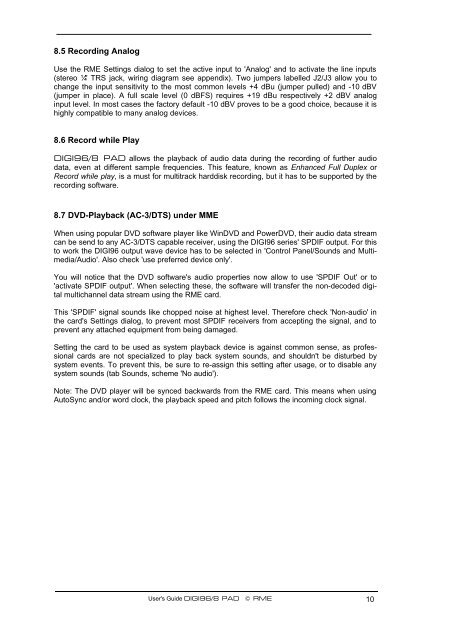You also want an ePaper? Increase the reach of your titles
YUMPU automatically turns print PDFs into web optimized ePapers that Google loves.
8.5 Recording Analog<br />
Use the <strong>RME</strong> Settings dialog to set the active input to 'Analog' and to activate the line inputs<br />
(stereo ¼" TRS jack, wiring diagram see appendix). Two jumpers labelled J2/J3 allow you to<br />
change the input sensitivity to the most common levels +4 dBu (jumper pulled) and -10 dBV<br />
(jumper in place). A full scale level (0 dBFS) requires +19 dBu respectively +2 dBV analog<br />
input level. In most cases the factory default -10 dBV proves to be a good choice, because it is<br />
highly compatible to many analog devices.<br />
8.6 Record while Play<br />
<strong>DIGI</strong><strong>96</strong>/8 <strong>PAD</strong> allows the playback of audio data during the recording of further audio<br />
data, even at different sample frequencies. This feature, known as Enhanced Full Duplex or<br />
Record while play, is a must for multitrack harddisk recording, but it has to be supported by the<br />
recording software.<br />
8.7 DVD-Playback (AC-3/DTS) under MME<br />
When using popular DVD software player like WinDVD and PowerDVD, their audio data stream<br />
can be send to any AC-3/DTS capable receiver, using the <strong>DIGI</strong><strong>96</strong> series' SPDIF output. For this<br />
to work the <strong>DIGI</strong><strong>96</strong> output wave device has to be selected in 'Control Panel/Sounds and Multimedia/Audio'.<br />
Also check 'use preferred device only'.<br />
You will notice that the DVD software's audio properties now allow to use 'SPDIF Out' or to<br />
'activate SPDIF output'. When selecting these, the software will transfer the non-decoded digital<br />
multichannel data stream using the <strong>RME</strong> card.<br />
This 'SPDIF' signal sounds like chopped noise at highest level. Therefore check 'Non-audio' in<br />
the card's Settings dialog, to prevent most SPDIF receivers from accepting the signal, and to<br />
prevent any attached equipment from being damaged.<br />
Setting the card to be used as system playback device is against common sense, as professional<br />
cards are not specialized to play back system sounds, and shouldn't be disturbed by<br />
system events. To prevent this, be sure to re-assign this setting after usage, or to disable any<br />
system sounds (tab Sounds, scheme 'No audio').<br />
Note: The DVD player will be synced backwards from the <strong>RME</strong> card. This means when using<br />
AutoSync and/or word clock, the playback speed and pitch follows the incoming clock signal.<br />
User's Guide <strong>DIGI</strong><strong>96</strong>/8 <strong>PAD</strong> © <strong>RME</strong> 10
















